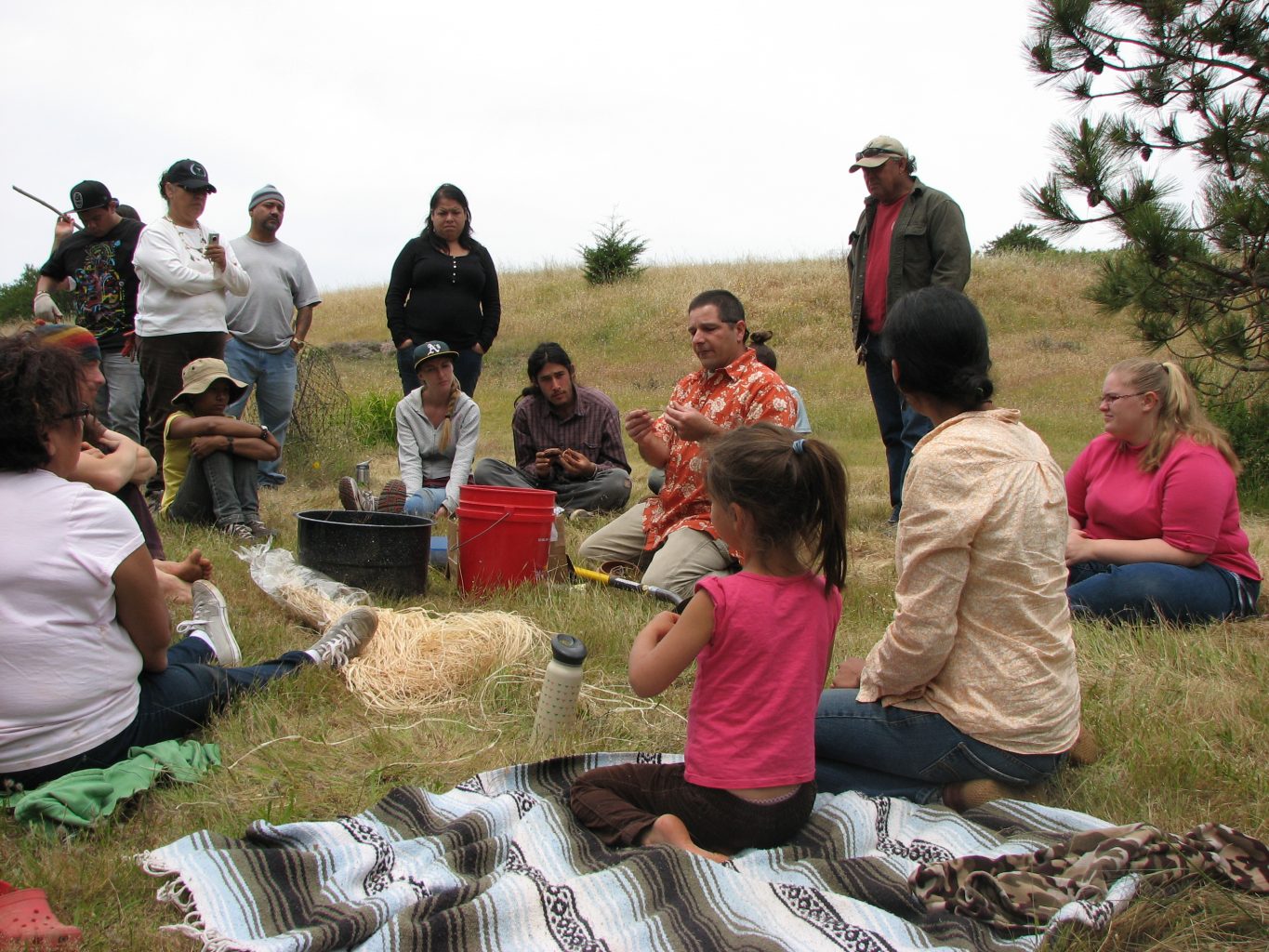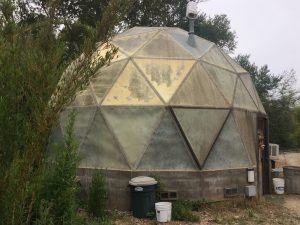Amah Mutsun Relearning Program / Future Garden of Force Majeure Center
Saturday, March 11, 10:00 – 2:00
Organized by T.J. Demos and Laurie Palmer
Free and open to the public (please bring snacks to share)
Part of an ongoing two-quarter long arts-led research project, this field trip begins with our investigation into extraction, designating capitalism’s fundamental logic of withdrawal—of value, nutrients, energy, labor, time—from people, lands, culture, life-forms, the elements, without corresponding deposit. Extraction forms hierarchies of power around divisions that are racially, ethnically, sexually, and ecologically defined. Faced with multiple tipping points moving us implacably toward a catastrophic environmentally altered future, with this field trip, we will consider possibilities and models for living non-extractively in ways singular and plural today. How do Indigenous ecologies, such as that of the Amah Mutsun Tribal Band, offer positive models for ecologically sustainable agriculture and the ongoingness of collective being within the environment? And how are artists, namely the Harrisons, building experimental systems of plant-based resilience for a climate-changed future? Please join us for this four-hour field trip that will provide a unique opportunity to visit the experimental research projects of both groups at the UC Santa Cruz Arboretum.

10:00 - 12:00: Visit to the Amah Mutsun Relearning Program with Rick Flores and Eleanor Castro
The Amah Mutsun Relearning Program (AMRP) at the UC Santa Cruz Arboretum is a collaborative effort between the Amah Mutsun Tribal Band (AMTB) and the Arboretum to assist the Tribe in their efforts of cultural revitalization, recuperation and relearning of dormant cultural knowledge, and environmental justice. This unique process of relearning combines science, research of Smithsonian ethnographer John P. Harrington (in particular his interviews with Mutsun elder and tribal matriarch Ascension Solorzano, and other Mutsun members, in the late 1920s), oral histories of Amah Mutsun tribal members, and knowledge and information from surrounding California Indian tribes with similar cultures. The Arboretum's California Native Conservation Gardens (CNCG) provide a place where Tribal members can relearn plant identification and uses of native plants while incorporating traditional ecological knowledge and traditional resource and environmental management into the growing and management of the plants which the Tribe can then sustainably harvest for cultural practices. The Gardens also are used to inform other collaborative projects in the area, such as the restoration work at Quiroste Valley Cultural Preserve and Pinnacles National Park; to inform land owners and managers about the best practices to manage cultural resources for healthy and resilient ecosystems; to educate UCSC students and students of all ages, and the general public about the importance of indigenous cultures and their knowledge. They also operate to spread knowledge about the history and contemporary issues of the AMTB, and how ethnobotany, traditional ecological knowledge and traditional resource and environmental management relate to contemporary efforts to restore degraded landscapes in California. We will be joined by Rick Flores, Steward of the Amah Mutsun Relearning Program at the UC Santa Cruz Arboretum, and Eleanor Castro is an Elder with the Amah Mutsun Tribal Band from San Juan Bautista.
Rick Flores is a graduate student in the Environmental Studies Department at UC Santa Cruz. His research focuses on the efforts of the Amah Mutsun Tribal Band (AMTB) to relearn traditional ecological knowledge and become active stewards in their traditional territory once again after a period of colonial dispossession. He is also the Steward of the Amah Mutsun Relearning Program at the UC Santa Cruz Arboretum, which is a collaborative effort between the Arboretum and the AMTB to assist the tribe in the relearning of plant identification, ethnobotany, and traditional resource and environmental management practices, as well as educating students and the public about California Indian lifeways. In addition, he is a Research Associate for the Amah Mutsun Land Trust which uniquely merges conventional land trust approaches with indigenous knowledge, techniques, and ideals, and is committed to protecting and celebrating cultural resources through creating opportunities for the AMTB to engage in traditional ways across the landscapes of their ancestors.
Eleanor Castro is an Elder with the Amah Mutsun Tribal Band from San Juan Bautista. She is the mother of four children and ten grandchildren and one great grandson. Eleanor lived in the Bay area for most of her childhood and married life but now resides in Fresno. She has been involved with the tribe for the last 10 years, and is currently a member of the Amah Mutsun Land Trust (AMLT) Board of Directors. She has participated in working with Kent Lightfoot and Rob Cuthrell and our Land Trust stewards out in the field. She has cooked for the field school and given spiritual guidance and personal advice to those who wish it. Eleanor is a traditional jewelry maker, and teaches tribal members and others their traditional cultural ways. Currently she is a contract teacher at the Fresno American Indian Health Project and teaches traditional beading and other cultural crafts. Eleanor is very active in her Native Community in Fresno and represents her tribe whenever and wherever possible. Her hope is to bring back her ancestors' ways and knowledge.

12:00 - 2:00: Visit to Future Garden, UCSC arboretum, by Helen Mayer Harrison and Newton Harrison
The Future Garden investigates the resilience of diverse plant species and whether they are capable of surviving under climate-changed conditions in coming decades. A long-term initiative of the Harrisons’ Force Majeure Center—a project begun in 2007 based on the acknowledgement that ecologically based, large-scale systems of adaptation to the extreme anthropogenic changes in the ever-warming environment are necessary for collective survival and so must be invented—Future Garden has multiple iterations, including: 1) The Garden of Hot Winds and Cold Rains, 2003, which asked “What would Bonn look like if the temperature rose three degrees Celsuis?” and built design proposals to answer the question; 2) Sagehen: A Proving Ground, 2011-ongoing, set in a UC Berkeley research station in California’s High Sierra mountains, which tests various plant species at different altitudes for their ability to survive in this area in the conditions of global warming predicted 50-100 years into the future; 3) Tibet is the High Ground, 2007-ongoing, examining shifting ecosystemic conditions responding to changes in glaciation and increased drought in the Tibetan Plateau; and 4) The Future Garden at UC Santa Cruz’s Arboretum, an experiment in progress situated in one of the Arb’s geodesic domes. Visiting the latter and joined by Newton Harrison, we will learn how the Harrison’s test the value to ecosystems, under climate stress, of assisting the migration of species ensembles; and if there are ecologically available responses that can replace, in some measure, the value once provided by disappearing glaciers and snowmelt to river systems, and to both the ecosystems and the human cultures they support?
Among the leading pioneers of the eco-art movement, the collaborative team of Newton and Helen Mayer Harrison, based in Santa Cruz, have worked for over forty years with biologists, ecologists, architects, urban planners and other artists to initiate collaborative dialogues to uncover ideas and solutions which support biodiversity and community development. The Harrisons’ concept of art embraces a breathtaking range of disciplines. They are historians, diplomats, ecologists, investigators, emissaries and art activists. Their work involves proposing solutions and involves not only public discussion, but also community involvement and extensive mapping and documentation of these proposals in an art context. Past projects have focused on watershed restoration, urban renewal, agriculture and forestry issues and urban ecologies. The Harrisons’ visionary projects have, on occasion, led to changes in governmental policy and have expanded dialogue around previously unexplored issues leading to practical implementations variously in the United States and Europe. There is a large body of literature on their work. They have exhibited extensively in the United States and Europe, and been awarded grants from the National Endowment for the Arts, the European Union, and the German, Dutch, French and English Governments.
